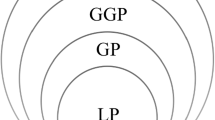Abstract
We compare three mathematical programming modeling languages, GAMS, OMNI and MathPro. To understand the properties of these languages, we formulate four linear programs in each language. The formulations are representative of the kinds of model structures one encounters in practice. Each of the languages focuses on a different view of linear programs. GAMS approximates algebra, OMNI uses the activity view and MathPro uses a block schematic. We summarize our experiences with the languages and suggest areas for further enhancement.
Similar content being viewed by others
References
R.W. Ashford and R.C. Daniel, LP-MODEL: XPRESS-LP's model builder, IMA J. Math. Manag. 1(1986)163–176.
J.J. Bisschop and A. Meeraus, On the development of a general algebraic modeling system in a strategic planning environment, Math. Progr. Study 20(1982)1–29.
Bonner and Moore Management Science,GAMMA 2000 User's Manual, Version 1.0, Houston, TX (1989).
Bonner and Moore Management Science,RPMS User's Manual, Houston, TX (1977).
R.L. Breitman and J.M. Lucas, PLANETS: A modeling system for business planning, Interfaces 17(1987)94–106.
A. Brooke, D. Kendrick and A. Meeraus,GAMS, A User Guide (The Scientific Press, Redwood City, CA, 1988).
Chesapeake Decision Sciences,MIMI/LP User Manual, Version 2.63, New Providence, NJ (1988).
Control Data Corporation,PDS/MAGEN User Information Manual, Version 1.1, Haverly Systems, Denville, NJ (1974).
K. Cunningham and L. Schrage, The LINGO modeling language, Technical Report, University of Chicago, Chicago, IL (1989).
R.E. Day and H.P. Williams, MAGIC: The design and use of an interactive modeling language for mathematical programming, IMA J. Math. Manag. 1(1986)53–65.
E.F.D. Ellison and G. Mitra, UIMP: User interface for mathematical programming, ACM Trans. Math. Software 8(1982)229–255.
R. Fourer, Modeling languages versus matrix generators for linear programming, ACM Trans. Math. Software 9(1983)143–183.
R. Fourer, D.M. Gay and B.W. Kernighan, Modeling languages for mathematical programming, Manag. Sci. 36(1990)519–554.
A. Geoffrion, SML: A model definition language for structured modeling, Working Paper No. 360, Western Management Science Institute, University of California, Los Angeles, CA (1988; revised November 1989).
A. Geoffrion, The SML language for structured modeling, Working Paper No. 378, Western Management Science Institute, University of California, Los Angeles, CA (1990).
H.J. Greenberg, A primer for MODLER: Modeling by object-driven linear elemental relationships, Mathematics Department, University of Colorado at Denver, Denver, CO (1990).
H.J. Greenberg and F.H. Murphy, Views of mathematical programming models and their instances, Technical Report, Mathematics Department, University of Colorado at Denver, Denver, CO (1991).
Haverly Systems,OMNI Linear Programming System: User and Operating Manual, Denville, NJ (1976).
Haverly Systems,MAGEN Reference Manual, Denville, NJ (1976).
T. Hürlimann,Reference Manual for the LPL Modeling Language (Version 3.1), Institute for Automation and Operations Research, University of Fribourg, CH-17700 Fribourg, Switzerland (1989).
T. Hürlimann and J. Kohlas, LPL: A structured language for linear programming modeling, OR Spektrum 10(1988)55–63.
C.V. Jones, Applications of a graph-based modeling system (GBMS), Technical Report 88-10-02, The Wharton School, University of Pennsylvania, Philadelphia, PA (1988).
C.V. Jones, An introduction to graph-based modeling systems, Part I: Overview, ORSA J. Comput. 2(1990)136–151.
Ketron Management Science,DATAFORM User Manual, McClean, VA (1987).
R. Krishnan, A logic based approach to model construction, SUPA Technical Report, Carnegie-Mellon University, Pittsburgh, PA (1988).
C.V. Jones, An introduction to graph-based modeling systems, Part II, ORSA J. Comput. (1991).
D.A. Kendrick and R. Krishnan, A comparison of structured modeling and GAMS, Comp. Sci. Econ. Manag. 2(1989)17–36.
C. Lucas and G. Mitra, CAMPS: Preliminary User Manual, Department of Mathematics and Statistics, Brunel University, Middlesex, UK.
P.-C. Ma, F.H. Murphy and E.A. Stohr, A graphics interface for linear programming, Commun. ACM 32(1989)996–1012.
MathPro, Inc.,MathPro Usage Guide, Introduction and Reference, Washington, DC (1990).
A. Meeraus, An algebraic approach to modeling,3rd Conf. on Economic Dynamics and Control, Lyngby, Denmark (1981).
F.H. Murphy and E.A. Stohr, An intelligent system for formulating linear programs, Dec. Support Syst. 2(1986)39–48.
F.H. Murphy, E.A. Stohr and A. Asthana, Representation schemes for mathematical programming models, Working Paper, New York University (1990).
W. Orchard-Hays,DATAMAT User Manual, National Bureau of Economic Research, Cambridge, MA (1978).
K.H. Palmer, N.K. Boudwin, H.A. Patton, A.J. Rowland, J.D. Sammes and D.M. Smith,A Model-Management Framework for Mathematical Programming (Wiley, 1984).
R.L. Sanders and M.G. Smith, A description of Bonner and Moore's GAMMA system, Report No. CSH-007, Bonner and Moore Managament Science, Houston, TX (1976).
R. Sharda and D. Steiger, Functional description of a graph-based interface for network modeling (GIN), Technical Report, Oklahoma State University, Stillwater, OK (1989)
L. Schrage,Linear, Integer and Quadratic Programming with LINDO (The Scientific Press, Redwood City, CA (1987).
J.S. Welch, Jr., PAM — A practitioner's approach to modeling, Manag. Sci. 33(1987)610–625.
R.V. Simmons, Mathematical programming modeling using MGG, IMA J. Math. Manag. 1(1986) 267–276.
H. Wagner,Principles of Operations Research (Prentice-Hall, Englewood Cliffs, NJ, 1975).
C. Witzgall and M. McClain, Problem specification for linear programs, IMA J. Math. Manag. 1(1985)177–209.
Author information
Authors and Affiliations
Rights and permissions
About this article
Cite this article
Greenberg, H.J., Murphy, F.H. A comparison of mathematical programming modeling systems. Ann Oper Res 38, 177–238 (1992). https://doi.org/10.1007/BF02283654
Issue Date:
DOI: https://doi.org/10.1007/BF02283654



